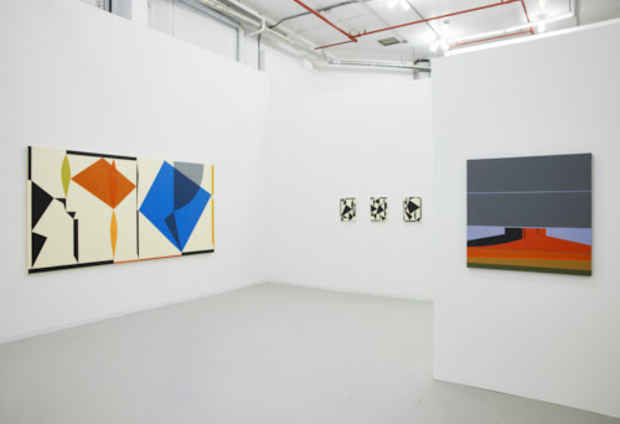Dan Namingha “Points Connecting: Land and Humanity”
David Richard Gallery

This event has ended.
David Richard Gallery presents Points Connecting: Land and Humanity, an exhibition of new paintings by Native American artist Dan Namingha in his first solo exhibition with David Richard Gallery in New York. The presentation includes 18 contemporary acrylic paintings on stretched canvases mostly created in 2020 and 2021, except for 4 paintings created in 2019. The largest painting (from 2019) measures 60 x 120 inches, while the rest are more easel-sized and range from 54 x 60 inches to 16 x 12 inches in size. Ten paintings from Namingha’s series, Points Connecting, are very contemporary with a Modernist sensibility and read as non-objective geometric abstractions with a combination of rectilinear and curvilinear forms in black situated on creamy white grounds and several with additional shapes in yellow, blue, red-orange and light green hues. The remaining eight paintings are reductive, relatively geometric landscape paintings comprised of mesas, night skies and mountains inspired by and referencing locations on Tewa lands on the Hopi reservations, mostly located in northern Arizona and northwestern New Mexico.
Namingha’s artwork is rooted in the following three highly interrelated areas: 1) being born into the Tewa-Hopi tribes, taught and lives the Native American traditions; 2) his family and ancestors with their longstanding cultural and artistic importance and art historical recognition; and 3) his formal and informal artistic training with an emphasis on traditional methods and contemporary abstract art.
Spanning naturalism and more contemporary approaches to art marking, including influences of abstraction and minimalism, as well as exploring a variety of methods and media including oil and acrylic paints, collage, watercolors and drawing on paper and sculpture, Namingha has successfully explored and depicted the symbols (including simplifications and fragments thereof), stories and heritage of his Tewa-Hopi culture. Further, he has melded that iconography and the mythologies with his interest in the southwestern landscape, contemporary art and state of mankind. To that end, this selection of paintings in the current presentation contemplates something very interesting, the Hopi culture and concern regarding the effect of man’s actions, not only with respect to each other, but also the future impact on the land and mankind in general.
Namingha’s series of paintings in this presentation, Points Connecting relate to the Hopi mythologies that man is of the earth and ultimately, returns to the earth and therefore, all people—past, present and future—are interconnected one to the other and to the land (the “points connecting” one to the other) through the concept of the circle of life and cycle of the seasons. Hence, the reason why he sees the aesthetics of abstraction and geometry very much related to the minimalist and geometric interpretations of the clean-lined Arizona and New Mexico landscapes with their mesas, wide-open vistas and bottomless, cloudless skies. Plenty of geometry, negative space and open expanses of uninterrupted color to tie the diverse imagery together, not only aesthetically, but also metaphorically with the Hopi cultural reference.
In addition to symbols, color has a significant meaning in Hopi culture. Colors relate to the four directions: north, east, south and west, as well as the four seasons and moments of conception, birth, maturation and death among other aspects of the circle of life. The colors of yellow, white, red and blue are in Namingha’s series Points Connecting. The use of black is significant as it references the “above”, the Upper World or the Fourth World which is the world that Hopi live in today. Related, but not specifically represented in the painting in this presentation is the concept of the Fifth World, the ramifications in the future of man’s decisions and choices today.
Dan Namingha, an accomplished and highly collected Hopi painter and sculptor, has artworks included in the permanent collections of more than 30 major museums (see below). He is a great-great-grandson of Nampeyo (1860-1942) on his mother’s side, who is considered to be the first internationally recognized Native American artist and often acknowledged for reviving the tradition of Hopi (Sikyátki Style) pottery. His mother, Dextra Quotskuyva Nampeyo (born September 7, 1928), Nampeyo’s great granddaughter, was the first Nampeyo potter to make commodity works for public sales.
Always artistically inclined and talented as a child, Namingha pursued art studies at University of Kansas, Lawrence, Kansas, then the Institute of American Indian Arts in Santa Fe, New Mexico and later at the American Academy of Art in Chicago, Illinois.
Namingha was awarded the “Living Treasure Award” from the Museum of Indian Arts and Culture, Santa Fe, New Mexico in 2016; an “Honorary Doctorate” from the Institute of American Indian Arts, Santa Fe, New Mexico in 2009; and the “New Mexico Governor’s Award for Excellence in the Arts” – Santa Fe, New Mexico in 1995, among numerous other awards. He was the subject of 2 PBS documentaries in 1985 and 1992, as well as national interviews in 1988 by Charlie Rose on CBS Night Watch and 1989, “The Art of Dan Namingha”, filmed for CBS Sunday Morning with Charles Kuralt.
Namingha lives with his wife Francis who runs their family gallery and works in Santa Fe, New Mexico. Both of his sons, Arlo and Michael are also established and successful artists.
Media
Schedule
from June 23, 2021 to July 16, 2021